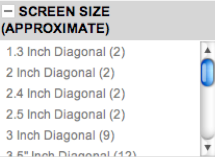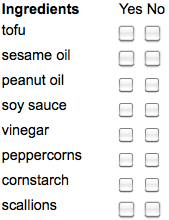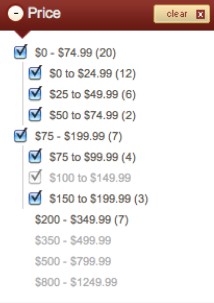Single Selection Versus Multiple Selection
The majority of faceted interfaces today permit only one selection per facet dimension. For example, for the facet color, a user can select only one value such as Color: Red. Single-selection interfaces convey only Boolean expressions, in the following form:
- (color:red)
- (size:small)
This is perfectly adequate for many tasks. However, multiple selection serves some task better—especially those that involve arbitrarily defined sets of values or subjective values that have many potential alternatives. Multiple selection also permits a retailer to worry less about perfecting and normalizing values in large bodies of metadata. In many cases, this is an enormous benefit, because users can compensate for the lack of perfectly normalized data simply by selecting multiple values. Figure 1 exemplifies the failure of a single-selection interface on J&R, because of a data normalization problem.

Users who want either a 2.4-inch or a 2.5-inch screen—a seemingly trivial distinction—must try both of the selections individually. Within the context of another selection that a user has made with a single-selection interface—such as brand—this would require a user to painstakingly make his selections for each of these screen sizes. In contrast, with a multiple-selection interface, a user can simply select both values—after shrugging at the perversity of J&R’s bothering to make such a distinction. To fix this problem, J&R could also have rounded off both screen sizes to half an inch. However, such cases might be different in LCD TVs and yet again for computer monitors—making for very troublesome normalization work indeed.
Multiple-selection interfaces are making appearances on many new retailer Web sites. Google’s recipe search also takes a multiple-selection approach for ingredients, as shown in Figure 2.

As a general example, a user who is searching for red or blue clothing in sizes L to XXL needs to convey this expression:
(color:red or color:blue) and (size:l or size:xl or size:xxl)
Users can do this in a straightforward manner using a multiple-selection interface, while they’d struggle with a single-selection interface. In some cases, it is possible to simulate multiple selection in situations where ranges of values are expressed as & up, as in the user interface shown in Figure 3, which I sighted at Macys.com. But this is the end of the road for single selection.

So multiple selection works very well for non-hierarchical facets. Unfortunately, it seems that multiple selection cannot coexist at all with hierarchical facets—or can it? Pete Bell![]() of Endeca, in his blog post “Bring Back the Dead Ends,”
of Endeca, in his blog post “Bring Back the Dead Ends,”![]() says “Multi-select and hierarchy [don’t work well together], where … you get split ends.” Split ends occur when a user selects two or more values on the first level of a tree, then in turn, drills into those values. The user may also drill to differing levels within each value. At that point, the tree becomes difficult or impossible to display in an intuitive and space efficient way. You can find my comment
says “Multi-select and hierarchy [don’t work well together], where … you get split ends.” Split ends occur when a user selects two or more values on the first level of a tree, then in turn, drills into those values. The user may also drill to differing levels within each value. At that point, the tree becomes difficult or impossible to display in an intuitive and space efficient way. You can find my comment![]() with the original seeds of my discussion in this article on Pete’s blog, Search Facets.
with the original seeds of my discussion in this article on Pete’s blog, Search Facets.

